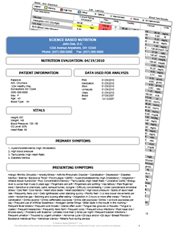Many infants and children develop high fevers with minor viral illnesses. Fever is an important part of the body’s defense against infection. Most bacteria and viruses that cause infections in people thrive best at 98.6 °F (1). The American Academy of Pediatrics describes that fever is not a disease, but a sign that your body is doing what it’s supposed to do to fight infection. They quote: “Fever is not an illness, rather, it is a symptom of sickness and is usually a positive sign that the body is fighting infection.”
In 1980 Dr. Barton D. Schmitt published an article in the journal Pediatrics and Adolescent Medicine concluding that most parents (52%) have “fever phobia” in which they believe that moderate fevers cause serious neurological effects and brain damage. Therefore most were likely to treat a fever aggressively: 85% gave drugs to reduce the fever (2). In 2001, a group at John Hopkins revisited this work of Dr. Schmitt and concluded that the fears and misconceptions of parents still persist (3).
Febrile seizures do not occur in most children, and although they can be frightening to parents, the vast majority of febrile seizures are short and harmless. According to the National Institute of Neurological Disorders and Stroke, there is no evidence that short febrile seizures cause brain damage. Large studies have found that children with febrile seizures have normal school achievement and perform well on intellectual tests. Brain damage from a fever should not be of concern and generally will not occur unless the fever is over 107.6 °F (42 °C) (1). Health care providers have an impact on parental understanding of fever and its severity. Medical care practices may need to inquire about educational interventions concerning fever and its role in illness.
It is rare for a fever to rise higher than 104 or 105 degrees F, and as long as your child does not seem distressed, there is no harm in letting a fever run its course. Fevers tend to spike in the late afternoon and evening, so a slight increase in fever during this time is not necessarily cause for alarm (4). Fevers caused by infection will rarely go over 105 °F unless the child is overdressed or trapped in a hot place. With that in mind, do not bundle someone up who has the chills, and be sure to remove excess clothing and blankets.
There are many benefits of having a fever when a child or adult is experiencing flu-like symptoms. Many of these benefits help ward off the cause of the illness. Antibodies and white blood cells typically elevate in order to fight off the virus or bacteria. Therefore, lowering a fever with medications is not recommended. Medications can cause potential side effects including liver damage and stomach upset. Febrile lowering drugs can also mask your symptoms telling you to return to work or play before the body is ready. Medications may actually prolong the illness. A series of vaccine studies done at the University of Maryland concluded that aspirin and acetaminophen suppressed production of antibodies and increased cold symptoms, lengthening the time of infection. The current study compared the duration of illness in those who received the medication with those who did not and found that flu sufferers who took one of the anti-fever medications were sick an average of 3.5 days longer than people who did not take either of the drugs (5).
However, there is a time and a place to seek medical attention. Necessity of intervention is recommended if there is presence of the following:
- Fever in an infant younger than 3 months (at any temperature)
- Fever above 102.2 degrees F in children between 3 months and 36 months, if they appear ill
- Anytime a fever rises over 104.5 degrees F
To Prevent Colds & Flu (Adults 150+lbs)
- Wash your hands! Good sanitary habits are important.
- Strictly avoid all dairy products: review our March 2008 and April 2008 newsletters on Dairy.
- Stay hydrated: drink 1 qt of water per 50lbs of body weight not to go over 3 qts per day.
- Get adequate protein: 1 out of 4 bites should be good protein sources like seeds, nuts, sprouts, quinoa, chicken, eggs, fish, etc.
- Reduce/eliminate non-nutritive and refined foods. Bacterium love sugar!
- Exercise at least 30 minutes, 3 days per week.
- Supplementation (spread dosages throughout the day & take with meals)
- Take a high potency multiple.
- Lauricidin: one scoop each day.
- Vitamin C: 3000mg each day.
- Vitamin D3: 5000IU (cholecalciferol) each day…especially in winter months.
- Zinc lozenge: one 15mg lozenge per day.
Prevention for kids (40-100lbs)
1-6 above are the same
Supplementation (spread dosages throughout the day & take with meals)
- Take a high potency multiple for kids.
- Lauricidin: ½ scoop each day.
- Vitamin C: 500-1000mg each day. Try Emergen-C or Child Life Vitamin C for kids.
- Vitamin D3: 1000IU (cholecalciferol) each day. Try Child Life Vitamin D.
- Zinc lozenge: ¼ -½ of a 15mg lozenge per day. Watch out for hidden artificial colors and sweeteners.
Cold and Flu Relief (Adults 150lbs)
- Strictly avoid all dairy.
- Hydration: drink 1qt of water per 50lbs of body weight not to go over 3qts per day.
- Supplementation (spread dosages throughout the day & take with meals)
- Take a high potency multiple.
- Lauricidin: 3 scoops per day.
- Vitamin C: 6000mg per day or to bowel tolerance. Try Emergen-C it helps you stay hydrated, and is effervescent-settling to the stomach. Careful! Too much will give you diarrhea.
- Vitamin D3: 10000IU (cholecalciferol) for 3 days then drop to 5000IU each day.
- Echinacea: 150mg, 6 times per day.
- Zinc Lozenges: Take 4-6, 15mg zinc lozenges for a few days.
- If you have no appetite or experience nausea/vomiting, sip on Green’s First or Nanogreens throughout the day. They’re both very nutritious and help to settle the stomach. Try them cold or warm.
- Do you have upper respiratory symptoms or a phlegmy cough? Add Elderberry syrup in a product called “Sambucal” per label instructions.
Relief for kids (40-100lbs)
#1 and #2 are the same.
Supplementation (spread dosages throughout the day & take with meals)
- Take a high potency multiple vitamin.
- Lauricidin: take 1-2 scoops per day.
- Vitamin C: take 500-1000mg per day. Try Emergen-C or Child Life Vitamin C for kids.
- Vitamin D3: take 1000IU (cholecalciferol) each day. Try Child Life Vitamin D.
- Echinacea: Find a children’s version at your health food store and take as recommended on the bottle. Watch out for hidden artificial colors and sweeteners.
- Zinc Lozenges: Take 1-2, 15mg zinc lozenges for a few days. Watch out for hidden artificial colors and sweeteners.
- If the child seems to have no appetite or experience nausea/vomiting, sip on Green’s First or Nanogreens throughout the day. They’re both very nutritious and help to settle the stomach. Try them cold or warm.
- Are there upper respiratory symptoms or a phlegmy cough? Add Elderberry syrup in a product called “Sambucal” per label instructions.
Get adjusted by your chiropractor. Chiropractors do not treat fevers. A chiropractor detects and corrects the vertebral subluxation complex. If there is restriction in vertebral segments this can cause interference with the nervous system. Therefore, maintaining or returning to a normal body temperature may be impaired. Once the proper chiropractic adjustment is given the body usually responds in a short period of time. This is not to say that a fever will break, as in some cases the fever will actually rise allowing the body to better fight off invading bacteria before returning to normal at a later period of time (6).
References:
- Kaneshiro, Neil. MD. Fever. MedlinePlus Medical Encyclopedia. January 29, 2010 http://www.nlm.nih.gov/medlineplus/ency/article/003090.htm. Accessed Feb. 21, 2012
- Schmitt, Barton D. MD. “Fever Phobia: Misconceptions of Parents About Fevers” Am J Dis Child. 1980;134(2):176-181.
- Crocetti, Michael MD., Moghbeli, Nooshi BA, et.al. Fever Phobis Revisited: Have Parental Misconceptions About Fever Changed in 20 Years? American Academy of Pediatrics. July 14, 2000
- Dr. Mercola, Joseph, “Do you make this common mistake when your child is sick?” February 3, 2011 http://articles.mercola.com/sites/articles/archive/2011/02/03/the-benefits-of-fever.aspx. Accessed February 21, 2012.
- University of Maryland schools of medicine and pharmacy. Pharmacotherapy, December 2000; 20: 1417-1422
- Zell, Paul D.C. Fevers. International Chiropractic Pediatric Association. March/April 2001

